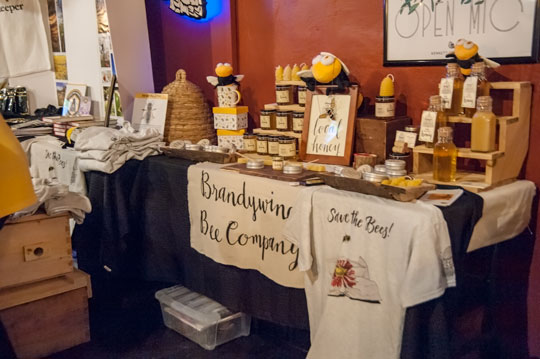Chester County beekeepers held a fundraiser at the Kennett Brewing Co. Saturday with a goal of educating new beekeepers and the general public on how they can help preserve and rebuild a declining honeybee population.
Jack McMichael, treasurer of the Chester County Beekeepers Association, said the shrinking bee population is not as extreme as was originally reported a few years ago, but it is bad. He explained that in the 1960s and ’70s, there were 6.5 million commercial hives in the country. Today, that number is down to 2.25 million.

The reason for the concern over the loss of honeybee numbers is that the bees pollinate 80 percent of the country’s food crops. Other pollinators — birds, bats and butterflies — are also in trouble. Pesticides hurt all of them, he said, but the biggest culprit killing off the bees is a mite, the Varroa destructor (Varroa mite) which came to the United States and Canada in late 1980s.
"It’s similar to a tick, but affects honey bees," he said. "It doesn’t drink the blood, but it eats a bee’s fat body, something like our liver. It can also cause a form of sudden dementia in bees, so they forget how to get home."
The money raised during Saturday's event goes to a pollinator protector program designed to educate new beekeepers. While it’s good they want to raise bees, McMichael said, it’s a double-edged sword because while there are more bees, there’s less food for those extra colonies.
He said the bees feed on newly blossomed flowers, plants and even weeds, including dandelions.
"From March and into July, the bees store food more than they eat, but once those plants stop blossoming, the reverse is true. They eat more than they store," McMichael said.
The group wants people — both beekeepers and others who want to help the bees — to know that the best thing they can do is to plant late-blooming flowers, bushes and trees. For the spring feeding, bees like dandelions, maple and black walnut trees.
Beekeepers have several means of fighting the Varroa. One way is to dust a colony with powdered sugar, McMichael said. The sugar makes the mite lose its grip. However, he said chemical treatment is also necessary for a keeper to make sure the colony survives.
About Rich Schwartzman
Rich Schwartzman has been reporting on events in the greater Chadds Ford area since September 2001 when he became the founding editor of The Chadds Ford Post. In April 2009 he became managing editor of ChaddsFordLive. He is also an award-winning photographer.



Comments